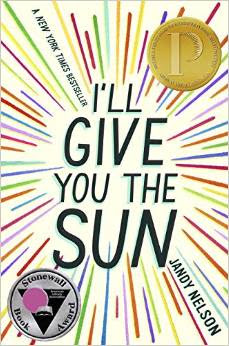Summary: This one hadn’t been on my immediate radar until I signed up to attend the Printz award ceremony at ALA in San Francisco at the end of June—and then I decided I’d better get going on reading the winner of that prestigious honor if I wanted to get the most out of the author’s speech and the experience as a whole. Plus, it would really be a much better thing to have read the book if I somehow ended up talking to the author…which I didn’t, but if I had, I’d have told her that her book is amazing and I wish I’d written it.
I’ll Give You the Sun is about family and love, art and grief; in short, all of the joys AND tragedies that always seem to happen at the same time. It’s about the less visible wounds suffered when we don’t communicate our needs or sorrows, and the healing that can happen when we are finally able to express what’s inside. Sometimes we just need to talk to the right person, find the right medium to say what we need to say.
Jude and Noah are fraternal twins, both artistic in their own unique ways, and as children they were as close as close can be–until their family started to unravel. Around age 13, we see Noah begin to be bullied by older boys, and his only way out seems to be the hope of admission to the local arts high school, a place where he can be himself among like-minded outsiders. He throws himself into his artwork with a frenzy. Meanwhile, Jude, too, has a creative side, but she feels like nobody notices it, not even their artistic mother, who seems only to have eyes for Noah’s work.
Here’s where the unraveling starts. Noah doesn’t talk about his physical injuries, or the fact that he’s in love with the boy next door. Jude doesn’t talk about her injured feelings or her jealousy. And so much is still left unsaid when tragedy strikes their family.
Peaks: This story is told in alternating viewpoints—and alternating timelines. It’s incredibly deftly woven. We begin with Noah’s story, when he’s nearly thirteen and the bullying begins in earnest. But when we switch to Jude, it is over three years later. Jude, who felt like the uncreative twin, is the one at the arts high school. Noah, for all intents and purposes, seems like “the normal one.” And so what could be a straightforwardly structured “issue book” or a quieter story about coming of age and sexuality and finding one’s calling, becomes a page turner because not only is the reader left wondering “how did we get to THIS point?” but also because the story in the present still has somewhere to go. And where it goes is full of surprises.
The message here is one of healing and family, above all—not just the family you’re born with but the family whom you choose and who finds you. It’s about serendipity and magic in the everyday, and the creative vitality none of us can truly live without. Even the romantic bits are about healing what’s broken inside of us. It’s also about grief and the terrible sadness that can balloon out from one small mistake left to fester, but the important take-away is that healing is always possible, and often in ways we don’t expect.
Valleys: I have to admit: after reading the first chapter, I was not sure I was going to like this story. The opening scene (minor spoilers) depicts an intense confrontation in which a barely-thirteen-year-old Noah is physically bullied by older boys, and yet it’s also a scene of sexual awakening and realization. It was very uncomfortable to read, but if I had given in to my initial discomfort I would never have experienced the rest of it. So. If you find yourself a little put off with the strange place where the story begins, give it time.
Conclusion: I haven’t gone into too much detail—in part to avoid spoilers, but also because it’s simply impossible to encapsulate this story in a brief summary. As an artist, there was a lot here that tugged at my heart and soul: it’s vivid and visual and visceral. At times it’s very painful, because each and every character hides his or her own private tragedy, and you kind of have to choose to heal in order to set things in motion again. But ultimately the characters (young protagonists and adults alike) felt so very real, and I couldn’t help but follow them through thick and thin. Mind-blowing, and not like anything I’ve read before. The only thing that comes to mind at all is Going Bovine by Libba Bray, another Printz winner, and they’re not alike at all, really, except for quality of characterization, depth of story, and other intangibles. Just…read it, I guess.
I purchased my copy of this book as a Kindle ebook. You can find I’LL GIVE YOU THE SUN by Jandy Nelson at an online e-tailer, or at a real life, independent bookstore near you!
